West Coast e-Postcard #3
from Our West Coast Train Triangle
September 18 to October 18, 2010
Hi All --
WEST COAST TRIANGLE: SIDES 2.5 & 3
The Road Sign says “Curves Ahead”, So What Did We Just Drive Through?

At last report we were at the Oregon-California border. From the Olympic
peninsula, we had been taking the Coastal Highway 101. Soon after
crossing into California, Hwy 1 (CA’s Pacific Coast Highway) split off from Hwy
101. People mentioned that the beginning of Hwy 1 was the roughest. Sure
enough, the first 26 miles were constant curves as Tim drove over ridges
and around mountains. Signs indicated narrow bridges, falling rocks,
curves ahead, and no RVs past certain points. A road sign stating “Congestion”
meant there was a Rock City or other tourist trap ahead. There were lots
of bicyclists on the non-existent shoulder, tempting fate. And we had not
even seen the ocean yet. Luckily, Di had taken her Dramamine and Tim was
steady on the road.
Bigger Trees and Errant Elk
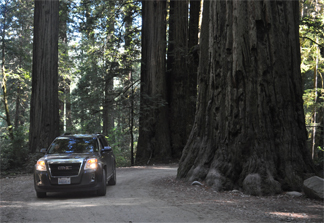
Finally, the view opened up onto the Pacific, with clear skies and endless
coastline. At the beginning of Hwy 1, there were few towns but many
interesting sights. Although we had seen some large trees in Oregon and
Washington (like the tallest Sitka Spruce in Oregon creatively called “Big
Tree” and the Grove of the Patriarchs in WA), we were now in redwood
country. It started with the Stout Grove, where a dirt road led to a
walking trail amid huge redwoods. Although you couldn’t drive a car
through them, they were almost beyond belief. There is something about
very tall trees over 1,500 years old that puts your life into perspective. We
then pulled off Hwy 1 to travel the Avenue of the Giants, a 36 mile road
lined with more enormous trees, some within inches of the road. We walked
several trails and learned that the redwoods are fairly fire resistant but
have shallow roots, so most fall due to windstorms. Even the fallen trees
were impressive as they served as “nursery trees” for the next generation
of redwoods.
In one state park there was reported to be a herd of Roosevelt elk. We
stopped at Elk Grove, a signed elk lookout, and other reputed elk hangouts
with nary an antler in sight. As we drove away, bemoaning our lack of elk
photos, we saw a few cars stopped along the side of the road.
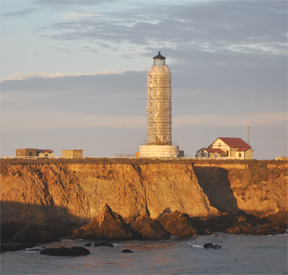 For those
of you who have been to Yellowstone, this is known as a jam, in this case an
elk jam. There they were, the elk resting next to a vacation home for
rent, unaware that they were truant from Elk Grove. Or maybe just having
the last laugh on the tourists.
For those
of you who have been to Yellowstone, this is known as a jam, in this case an
elk jam. There they were, the elk resting next to a vacation home for
rent, unaware that they were truant from Elk Grove. Or maybe just having
the last laugh on the tourists.
Lighthouse Under Wraps
We were looking forward to the next night’s accommodations, the
LightKeeper’s Room at the Point Arena Lighthouse. Tim had been taking
photos of any accessible lighthouse on the coast and we could tell from
brochures that Point Arena’s would be stunning. Well, maybe it was
stunning, but as we drove towards it, we saw that the lighthouse was
almost completely covered in plastic sheeting, with only the top glass area
showing! The lighthouse was being repainted and the beautiful Fresnel lens
was replaced by an electronic light (the original lens was in the
visitor’s center). To add insult to injury, they had changed the tour hours and we
missed the last lighthouse tour by 10 minutes. All was not lost, though;
we stayed in a small room with great views of both the coast and the
lighthouse in a poncho, walked the grounds, and took the first tour the
next morning. And, upon request, you can see Tim’s many photos of the
lighthouse at dusk, sunset, sunrise, and reflected in a door window….all
dressed in plastic.
Wildflowers, Wild Waves and Wildlife
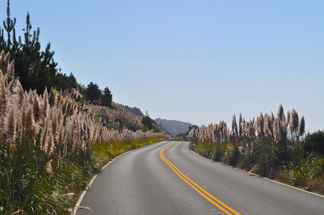
Once you are south of the redwoods, the hills of California in October are
mostly brown and dry. Occasionally there were small patches of some very
hardy and colorful wildflowers. However, there seemed to be ever
increasing stands of tall, healthy looking pampas grass, with its feathery
fronds waving in the wind. The pampas grass was growing on desolate
hillsides as well as along the roadside, blocking some of the ocean views. This plant is considered an invasive species here, but it is growing in so
many areas that would be difficult to reach, we don’t know how it can be
controlled.
As you go around mountains and down to the ocean level, there is a
continuous display of two signs, “Entering Tsunami Danger Area” and
“Leaving Tsunami Danger Area”. Within the tsunami areas there are also
evacuation route signs. Usually these involve steep unpaved roads or
cliffsides. I guess if a tsunami were to hit while we were here, we’d
have to just hold our breaths, because we’d never make it up the hills in time.
There are lots of homes and towns in the danger areas, and we are close to
the San Andreas Fault, so some people like to live dangerously. Di would
be a nervous wreck living here wondering if that noise was a big wave or
the Big One!
As we drove south, the area became more populated. We stopped at Bodega
Bay’s Visitor Center and heard that a couple of juvenile whales had been
sighted. This was an unexpected surprise as whales don’t usually migrate
through here until December.
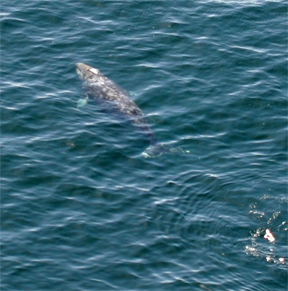 Di thought she had seen a whale earlier with
binoculars (Di had the binoculars, not the whale), but there were no
collaborating witnesses. At Bodega Bay we saw several sightings along
with some seals on rocks. We are still not sure if it was one whale seen
several times or several whales seen once. The whale sightings were nothing more
than a water spout with a whale back and maybe the fluke (tail). But
better sightings were in store. The next day, while walking to the Point
Reyes Lighthouse, we saw a whale even closer. It played around near shore
and hovered for a while just under the surface. Tim got some great photos!
Di thought she had seen a whale earlier with
binoculars (Di had the binoculars, not the whale), but there were no
collaborating witnesses. At Bodega Bay we saw several sightings along
with some seals on rocks. We are still not sure if it was one whale seen
several times or several whales seen once. The whale sightings were nothing more
than a water spout with a whale back and maybe the fluke (tail). But
better sightings were in store. The next day, while walking to the Point
Reyes Lighthouse, we saw a whale even closer. It played around near shore
and hovered for a while just under the surface. Tim got some great photos!
We also saw (and heard) sea lions and a big buck elk. Wow, this was like
being on Wild Kingdom! To round out the wildlife viewing, later on by
Hearst Castle we saw numerous elephant seals (at a turnout called “Friends
of Elephant Seals”). A few young males were mock fighting, but most were
just lazing out in the sun.
Bay Watch
As we drove out to see the Point Bonita lighthouse, just north of San
Francisco, we heard a roar of airplanes. Overhead were what looked like
two small planes pursuing a bomber over the Golden Gate Bridge.
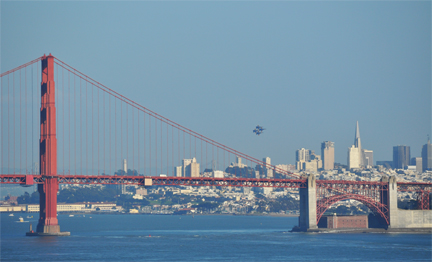 We had seen a video crew along the road and thought a movie was being made. Then
the Blue Angels flew by in precision formation. Tim was snapping photos
up and down. A ranger told us it was Fleet Week in SF; when aircraft
carriers, along with other ships and planes arrive for air shows and
parade of ships. It was tempting to stay here, but the crowds and potentially
expensive hotels dissuaded us. And we had visited SF before. So, crossing
our fingers, we attempted to take Hwy 1 through the city. It was a
breeze. In no time we were out of town and on our way south.
We had seen a video crew along the road and thought a movie was being made. Then
the Blue Angels flew by in precision formation. Tim was snapping photos
up and down. A ranger told us it was Fleet Week in SF; when aircraft
carriers, along with other ships and planes arrive for air shows and
parade of ships. It was tempting to stay here, but the crowds and potentially
expensive hotels dissuaded us. And we had visited SF before. So, crossing
our fingers, we attempted to take Hwy 1 through the city. It was a
breeze. In no time we were out of town and on our way south.
Next was a quick stop at Santa Cruz wharf for salt water taffy and a
souvenir shirt. There we saw a new (for us) water conveyance. Picture a
large surfboard with a person standing on top and paddling. Looks like a
quick way to end up in the water!
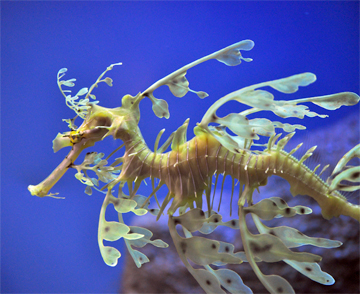
Then on to Monterey. That afternoon we walked the harbor and wharf, ate
the requisite seafood dinner and strolled down Cannery Row. This is where
sardines were canned for years and is the location of Steinbeck’s book by
the same name.
We love to visit aquariums and Monterey has one of the best. We had
advance tickets and got there early so we could check out some exhibits
without the crowds. The jellyfish and seahorse displays were phenomenal.
There were also areas concentrating in the bay sea life and maintaining
sustainable seafood supplies. During our special behind-the-scenes tour,
we got to feed the fish in the giant tank and see where the jellies are
raised. We finished the day with a drive around Pacific Grove and
Carmel-by-the-Sea and a visit to the old Mission San Carlos in Carmel.
Hill Castles and Beach Boardwalks
On our way south we did a quick walk to the McWay waterfall. It is unique
because in low tide, it falls 80 feet directly on the beach and in high
tide, into the ocean. We then stayed at the cute town of Cambria (see
Believe It or Not, below).
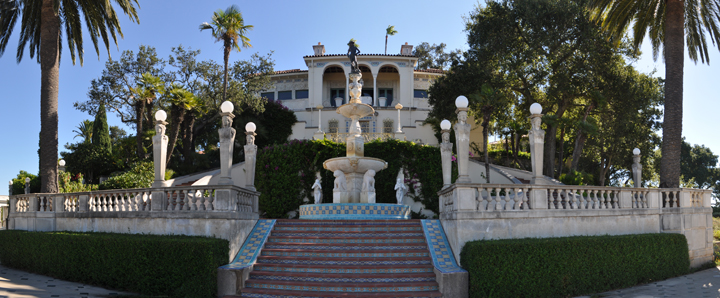 What’s a visit to southern coastal CA without
seeing Hearst Castle? We took the generic first-time tourist tour. All
the tours involve a 15 minute bus ride up to the estate, as there is no
visitor’s center up there. Besides the main home, there are several huge
guest houses (as in 17 bedrooms), remnants of a private zoo, a large
outdoor pool, a private theater as big as your hometown movie theater, and
a huge beautifully tiled indoor pool. The dining room has a very long
table set with formal dinnerware and bottles of Heinz and Del Monte
ketchup. The family ate on fancy plates but liked the condiments we all
do. Our tour guide had lots of information on the famous guests of Hearst
(like Bob & Delores Hope, Cary Grant, Harpo Marx, etc., and their antics).
We would like to come back during the December when the grounds are
decorated and guides dress in garb of the 30s and 40s.
What’s a visit to southern coastal CA without
seeing Hearst Castle? We took the generic first-time tourist tour. All
the tours involve a 15 minute bus ride up to the estate, as there is no
visitor’s center up there. Besides the main home, there are several huge
guest houses (as in 17 bedrooms), remnants of a private zoo, a large
outdoor pool, a private theater as big as your hometown movie theater, and
a huge beautifully tiled indoor pool. The dining room has a very long
table set with formal dinnerware and bottles of Heinz and Del Monte
ketchup. The family ate on fancy plates but liked the condiments we all
do. Our tour guide had lots of information on the famous guests of Hearst
(like Bob & Delores Hope, Cary Grant, Harpo Marx, etc., and their antics).
We would like to come back during the December when the grounds are
decorated and guides dress in garb of the 30s and 40s.
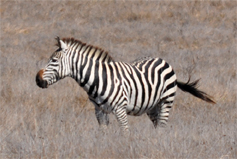 Along the road
back to Cambria, we saw a herd of zebras…..that’s right, zebras! They were
descendents of the ones Hearst kept in his zoo. And it was our first time
in a zebra jam.
Along the road
back to Cambria, we saw a herd of zebras…..that’s right, zebras! They were
descendents of the ones Hearst kept in his zoo. And it was our first time
in a zebra jam.
During the afternoon we walked a mile long boardwalk checking out the
surfers and potential tidepools. Di was anxious to investigate a tidepool,
so we came at sunset during low tide. Not many creatures here, but we did
see the living version of the sand dollars whose round flat shells are
common.
LA Goes on Forever (It Seems)
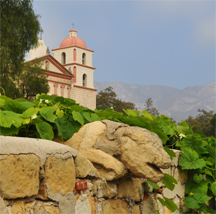
We awoke to fog so thick we couldn’t see the huge Morro Rock on the way to
LA. In fact, at times we couldn’t even see the water. Although we zipped
through SF, we had no illusions LA would be that easy. Relaxed by a quick
stop at the Santa Barbara mission and lunch at a local taqueria (actually,
Taco Bell), we headed for LA and its suburbs, determined to stay on Hwy 1.
Two and a half hours later, we left LA behind. Of course none of the
traffic lights in the area were timed, and there were some rather dingy
suburbs but we also saw the mansions of Malibu and never got lost. Tim
was the model of patience and careful driving. Glad we did it but if we came
back we’d take the freeway. Hmmm, last time we were on the LA freeway it
was seven lanes in both directions all stopped. So maybe we need to
reconsider.
San Diego – Our Kind of Town
After LA, the Coastal Highway merges with Hwy 5, so we took that on to
Santa Diego. Our goal was to return the rental car and use mass transit
for the rest of the trip. The transit system in Santa Diego made this
easy. After dropping off our bags at the downtown hostel, we drove just a
few miles to the airport, dropped off the car (incredibly dirty and with
raccoon tracks all over the hood) and took a bus back downtown.
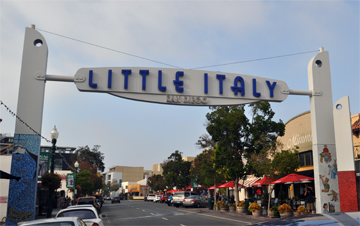 The harbor
was an easy walk away with the U.S.S. Midway, a submarine, the oldest
active ship, the 3-masted ship (the Star of India, 1863), and other
historic watercraft anchored. A longer walk took us to Little Italy (ahh,
gelato, how I have missed you!) then back to the hostel.
The harbor
was an easy walk away with the U.S.S. Midway, a submarine, the oldest
active ship, the 3-masted ship (the Star of India, 1863), and other
historic watercraft anchored. A longer walk took us to Little Italy (ahh,
gelato, how I have missed you!) then back to the hostel.
As most of you know, we usually try to cheap out on accommodations when we
travel, staying at hostels when we can. There are few hostels in the
U.S., but in San Diego we found the 500 West Hotel. It was originally built as
an Army/Navy YMCA for visiting service men. Now it has very inexpensive
rooms in a great location and right next to the much lusher Weston. Yeah,
the rooms are small and spartan, and you have to go down the hall for a
private bathroom, but the location is perfect and the place is very clean.
The communal kitchen allowed us to make breakfasts and eat salad bar
dinners. The West Coast is a notch more expensive than home. A simple
omelet runs $8, a bottle of Coke for almost $2, and it is hard to find
lunch for two under $20, so you save where you can.
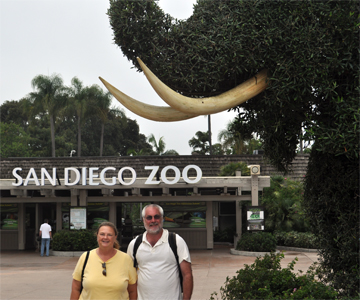 Travel hint: Stop at
the Visitor’s Center of a town first for free maps, advice on where to eat
cheaply or grocery shop, and buy discount tickets to the sights.
Travel hint: Stop at
the Visitor’s Center of a town first for free maps, advice on where to eat
cheaply or grocery shop, and buy discount tickets to the sights.
Armed with our discount tickets, we arrived via bus at the world’s largest
zoo, found in San Diego (see attached image). Once inside, there were lots
of ways to travel about included in the ticket price. You could take the
45 minute guided bus tour (we did), the cable car ride (Skyfari) to the
other end of the zoo (we did), or the express bus that stopped at
designated places. Instead of the last one, we chose to walk around
(sometimes in circles) to make sure we saw everything. Besides being the
largest zoo, it is also serves as a huge botanical garden with lots of
tropical plants. So there were photo opportunities galore. Bears, hippos,
rhinos, the colorful poisonous frogs, the always cute meercats, tree
kangaroos, and a fabulous koala bear exhibit were among our favorites.
There were several walk- through aviaries. We could see them from afar but
could not seem to find a direct, non circular path to them. While digging
in the zoo for a new building, they found 3,000 year old whale bones!
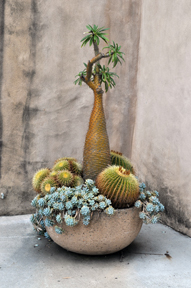 We
saw it all and six hours later headed back to the hostel foot weary but
200+ photos in hand. The inscription on one zoo bench said it all. “It’s
good to sit down”.
We
saw it all and six hours later headed back to the hostel foot weary but
200+ photos in hand. The inscription on one zoo bench said it all. “It’s
good to sit down”.
The zoo is part of the huge Balboa Park complex which houses gardens,
museums and artists workshops. We headed back the next day and walked
about, visiting whatever was free. This included a small art museum (with
beautiful tapestries and a Rueben); a huge, slatted wooden greenhouse; and
a small village-like area where many artists had storefronts, producing
their work on site. The most surprising and outstanding areas were the
cactus and rose gardens. A cactus garden may not sound like the prettiest
place, but the varying shapes and sizes of cacti were amazing. Also,
there were quite a few in bloom. One had a flower with stalk almost as large as
the plant itself. Another had a magnificent white blossom….a stunning
contrast to the prickly plant. Across the way was a very large rose
garden. Hundreds of hybrid rose bushes, all labeled and in full bloom,
more colors than we’ve seen anywhere and some with wonderful fragrances.
Sigh, another 100+ photo day. Too bad we can’t take the smells home with
us as well (of the garden, not the zoo).
Three Countries and Disney in an Afternoon
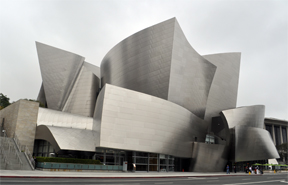
We finally packed our bags and headed out the next morning for the Amtrak
station, taking the Pacific Surfrider to LA to catch our train home. We
got into LA at noon so we had five hours to see the city. Armed with a
map, we walked about seeing Los Pueblos (the Hispanic area) and had a
Mexican lunch (not Taco Bell). Then a quick trek to Chinatown in search
of an elusive almond cookie and a photo of the dragon gate entrance. The
next stop was the Geary-designed Disney Concert Hall, a modern stainless steel
building that looked different from every angle. Although there was
limited access inside, we were able to walk all about the outside,
including hidden stairways and gardens. It was just a few more blocks to
Little Tokyo, a self contained area marked by a large pagoda (smaller and
less touristy than Chinatown). The highlight (so to speak) was the
exclusive Hello Kitty store. Then back to the Amtrak station and it’s all
aboard the Southwest Chief.
Side 3 of the West Coast Triangle
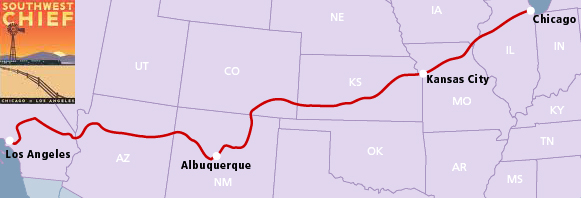
Back to our little sleepette for the 44 hour train ride to Chicago. Back
to great food, bunk beds, very tiny bathrooms, and an even smaller shower.
Views along the way were of the multicolored New Mexico buttes, dry flat
land of Nevada, and cornfields of Kansas. Our train car attendant,
Victor, provided interesting historic commentary as we travelled. It was a
relaxing way to end the trip. A short commuter train from Chicago to
Hinsdale to pick up the car, then home.
California: Believe It or Not!
* Although CA has a 5 cent deposit on bottles and cans, they cannot be
returned to the grocery store. You have to go to special centers with
limited hours to return recyclables. Not tourist or environmentally
friendly.
* Half Moon Bay, close to Monterey, calls itself the pumpkin capital of the
world. You can pick up your Halloween pumpkin from a patch. All the
pumpkins have been picked and placed in an empty field with all other
vegetation removed. Somewhat strange looking.
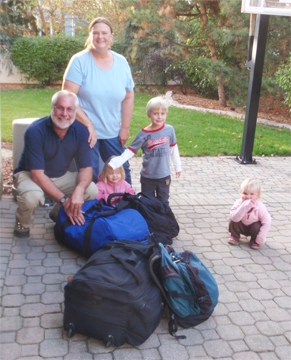
* Cambria, near Hearst Castle, is decorated for Halloween all over with
scarecrows at homes and businesses. The best one was the friar scarecrow
(complete with brown robe tied with a rope belt and fake birds on its
shoulder) in front of the Catholic church.
* Bicycles are so commonly used here that many busses have bike racks on
the front bumper. You hook up your bike and hop on the bus. Trains also
make taking a bike onboard easy.
* While walking in Monterey, we suddenly smelled a strong aroma of black
licorice. It was the wild fennel that we saw growing there and throughout
the state along the roadside. Some of the plants were taller than Di.
* Avocado is a topping option at Subways. Taco Bell has five kinds of
salsa in packets including green salsa and roasted pepper salsa (yum).
The End
Well, we did almost 4600 miles of train travel, exactly 2932 miles of
rental car miles (all driven by Tim), stayed in 21 different places
(homes, lodges, motels, hostels, and sleepettes) and (at last count) over 3,700
photos (mostly by Tim) in 31 days. Except for a few miles, we’ve
travelled all of Hwy 1 and 101 from top to bottom. At times it seemed like we were
in a different country! It was a wonderful trip. Thanks for letting us tell
you about it.
-- Di & Tim
 For those
of you who have been to Yellowstone, this is known as a jam, in this case an
elk jam. There they were, the elk resting next to a vacation home for
rent, unaware that they were truant from Elk Grove. Or maybe just having
the last laugh on the tourists.
For those
of you who have been to Yellowstone, this is known as a jam, in this case an
elk jam. There they were, the elk resting next to a vacation home for
rent, unaware that they were truant from Elk Grove. Or maybe just having
the last laugh on the tourists.



 Di thought she had seen a whale earlier with
binoculars (Di had the binoculars, not the whale), but there were no
collaborating witnesses. At Bodega Bay we saw several sightings along
with some seals on rocks. We are still not sure if it was one whale seen
several times or several whales seen once. The whale sightings were nothing more
than a water spout with a whale back and maybe the fluke (tail). But
better sightings were in store. The next day, while walking to the Point
Reyes Lighthouse, we saw a whale even closer. It played around near shore
and hovered for a while just under the surface. Tim got some great photos!
Di thought she had seen a whale earlier with
binoculars (Di had the binoculars, not the whale), but there were no
collaborating witnesses. At Bodega Bay we saw several sightings along
with some seals on rocks. We are still not sure if it was one whale seen
several times or several whales seen once. The whale sightings were nothing more
than a water spout with a whale back and maybe the fluke (tail). But
better sightings were in store. The next day, while walking to the Point
Reyes Lighthouse, we saw a whale even closer. It played around near shore
and hovered for a while just under the surface. Tim got some great photos!
 We had seen a video crew along the road and thought a movie was being made. Then
the Blue Angels flew by in precision formation. Tim was snapping photos
up and down. A ranger told us it was Fleet Week in SF; when aircraft
carriers, along with other ships and planes arrive for air shows and
parade of ships. It was tempting to stay here, but the crowds and potentially
expensive hotels dissuaded us. And we had visited SF before. So, crossing
our fingers, we attempted to take Hwy 1 through the city. It was a
breeze. In no time we were out of town and on our way south.
We had seen a video crew along the road and thought a movie was being made. Then
the Blue Angels flew by in precision formation. Tim was snapping photos
up and down. A ranger told us it was Fleet Week in SF; when aircraft
carriers, along with other ships and planes arrive for air shows and
parade of ships. It was tempting to stay here, but the crowds and potentially
expensive hotels dissuaded us. And we had visited SF before. So, crossing
our fingers, we attempted to take Hwy 1 through the city. It was a
breeze. In no time we were out of town and on our way south.

 What’s a visit to southern coastal CA without
seeing Hearst Castle? We took the generic first-time tourist tour. All
the tours involve a 15 minute bus ride up to the estate, as there is no
visitor’s center up there. Besides the main home, there are several huge
guest houses (as in 17 bedrooms), remnants of a private zoo, a large
outdoor pool, a private theater as big as your hometown movie theater, and
a huge beautifully tiled indoor pool. The dining room has a very long
table set with formal dinnerware and bottles of Heinz and Del Monte
ketchup. The family ate on fancy plates but liked the condiments we all
do. Our tour guide had lots of information on the famous guests of Hearst
(like Bob & Delores Hope, Cary Grant, Harpo Marx, etc., and their antics).
We would like to come back during the December when the grounds are
decorated and guides dress in garb of the 30s and 40s.
What’s a visit to southern coastal CA without
seeing Hearst Castle? We took the generic first-time tourist tour. All
the tours involve a 15 minute bus ride up to the estate, as there is no
visitor’s center up there. Besides the main home, there are several huge
guest houses (as in 17 bedrooms), remnants of a private zoo, a large
outdoor pool, a private theater as big as your hometown movie theater, and
a huge beautifully tiled indoor pool. The dining room has a very long
table set with formal dinnerware and bottles of Heinz and Del Monte
ketchup. The family ate on fancy plates but liked the condiments we all
do. Our tour guide had lots of information on the famous guests of Hearst
(like Bob & Delores Hope, Cary Grant, Harpo Marx, etc., and their antics).
We would like to come back during the December when the grounds are
decorated and guides dress in garb of the 30s and 40s.
 Along the road
back to Cambria, we saw a herd of zebras…..that’s right, zebras! They were
descendents of the ones Hearst kept in his zoo. And it was our first time
in a zebra jam.
Along the road
back to Cambria, we saw a herd of zebras…..that’s right, zebras! They were
descendents of the ones Hearst kept in his zoo. And it was our first time
in a zebra jam.

 The harbor
was an easy walk away with the U.S.S. Midway, a submarine, the oldest
active ship, the 3-masted ship (the Star of India, 1863), and other
historic watercraft anchored. A longer walk took us to Little Italy (ahh,
gelato, how I have missed you!) then back to the hostel.
The harbor
was an easy walk away with the U.S.S. Midway, a submarine, the oldest
active ship, the 3-masted ship (the Star of India, 1863), and other
historic watercraft anchored. A longer walk took us to Little Italy (ahh,
gelato, how I have missed you!) then back to the hostel.
 Travel hint: Stop at
the Visitor’s Center of a town first for free maps, advice on where to eat
cheaply or grocery shop, and buy discount tickets to the sights.
Travel hint: Stop at
the Visitor’s Center of a town first for free maps, advice on where to eat
cheaply or grocery shop, and buy discount tickets to the sights.
 We
saw it all and six hours later headed back to the hostel foot weary but
200+ photos in hand. The inscription on one zoo bench said it all. “It’s
good to sit down”.
We
saw it all and six hours later headed back to the hostel foot weary but
200+ photos in hand. The inscription on one zoo bench said it all. “It’s
good to sit down”.


